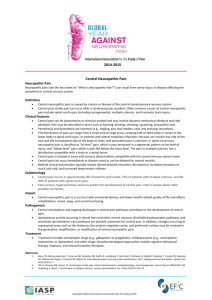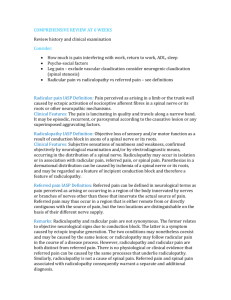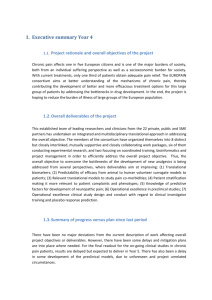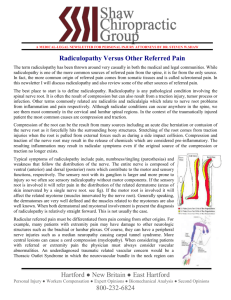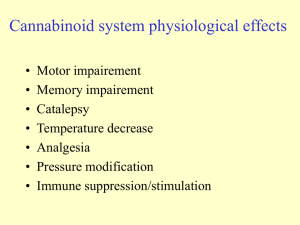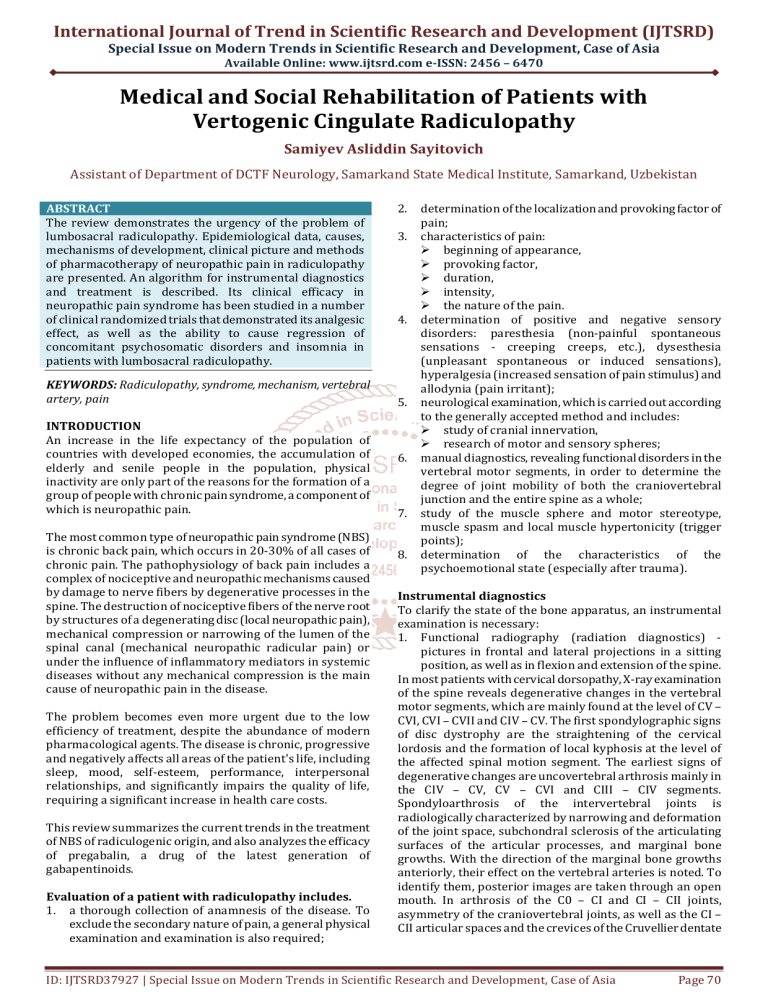
International Journal of Trend in Scientific Research and Development (IJTSRD)
Special Issue on Modern Trends in Scientific Research and Development, Case of Asia
Available Online: www.ijtsrd.com e-ISSN: 2456 – 6470
Medical and Social Rehabilitation of Patients with
Vertogenic Cingulate Radiculopathy
Samiyev Asliddin Sayitovich
Assistant of Department of DCTF Neurology, Samarkand State Medical Institute, Samarkand, Uzbekistan
ABSTRACT
The review demonstrates the urgency of the problem of
lumbosacral radiculopathy. Epidemiological data, causes,
mechanisms of development, clinical picture and methods
of pharmacotherapy of neuropathic pain in radiculopathy
are presented. An algorithm for instrumental diagnostics
and treatment is described. Its clinical efficacy in
neuropathic pain syndrome has been studied in a number
of clinical randomized trials that demonstrated its analgesic
effect, as well as the ability to cause regression of
concomitant psychosomatic disorders and insomnia in
patients with lumbosacral radiculopathy.
KEYWORDS: Radiculopathy, syndrome, mechanism, vertebral
artery, pain
INTRODUCTION
An increase in the life expectancy of the population of
countries with developed economies, the accumulation of
elderly and senile people in the population, physical
inactivity are only part of the reasons for the formation of a
group of people with chronic pain syndrome, a component of
which is neuropathic pain.
The most common type of neuropathic pain syndrome (NBS)
is chronic back pain, which occurs in 20-30% of all cases of
chronic pain. The pathophysiology of back pain includes a
complex of nociceptive and neuropathic mechanisms caused
by damage to nerve fibers by degenerative processes in the
spine. The destruction of nociceptive fibers of the nerve root
by structures of a degenerating disc (local neuropathic pain),
mechanical compression or narrowing of the lumen of the
spinal canal (mechanical neuropathic radicular pain) or
under the influence of inflammatory mediators in systemic
diseases without any mechanical compression is the main
cause of neuropathic pain in the disease.
The problem becomes even more urgent due to the low
efficiency of treatment, despite the abundance of modern
pharmacological agents. The disease is chronic, progressive
and negatively affects all areas of the patient's life, including
sleep, mood, self-esteem, performance, interpersonal
relationships, and significantly impairs the quality of life,
requiring a significant increase in health care costs.
This review summarizes the current trends in the treatment
of NBS of radiculogenic origin, and also analyzes the efficacy
of pregabalin, a drug of the latest generation of
gabapentinoids.
Evaluation of a patient with radiculopathy includes.
1. a thorough collection of anamnesis of the disease. To
exclude the secondary nature of pain, a general physical
examination and examination is also required;
2.
3.
4.
5.
6.
7.
8.
determination of the localization and provoking factor of
pain;
characteristics of pain:
beginning of appearance,
provoking factor,
duration,
intensity,
the nature of the pain.
determination of positive and negative sensory
disorders: paresthesia (non-painful spontaneous
sensations - creeping creeps, etc.), dysesthesia
(unpleasant spontaneous or induced sensations),
hyperalgesia (increased sensation of pain stimulus) and
allodynia (pain irritant);
neurological examination, which is carried out according
to the generally accepted method and includes:
study of cranial innervation,
research of motor and sensory spheres;
manual diagnostics, revealing functional disorders in the
vertebral motor segments, in order to determine the
degree of joint mobility of both the craniovertebral
junction and the entire spine as a whole;
study of the muscle sphere and motor stereotype,
muscle spasm and local muscle hypertonicity (trigger
points);
determination of the characteristics of the
psychoemotional state (especially after trauma).
Instrumental diagnostics
To clarify the state of the bone apparatus, an instrumental
examination is necessary:
1. Functional radiography (radiation diagnostics) pictures in frontal and lateral projections in a sitting
position, as well as in flexion and extension of the spine.
In most patients with cervical dorsopathy, X-ray examination
of the spine reveals degenerative changes in the vertebral
motor segments, which are mainly found at the level of CV –
CVI, CVI – CVII and CIV – CV. The first spondylographic signs
of disc dystrophy are the straightening of the cervical
lordosis and the formation of local kyphosis at the level of
the affected spinal motion segment. The earliest signs of
degenerative changes are uncovertebral arthrosis mainly in
the СIV – СV, СV – СVI and СIII – СIV segments.
Spondyloarthrosis of the intervertebral joints is
radiologically characterized by narrowing and deformation
of the joint space, subchondral sclerosis of the articulating
surfaces of the articular processes, and marginal bone
growths. With the direction of the marginal bone growths
anteriorly, their effect on the vertebral arteries is noted. To
identify them, posterior images are taken through an open
mouth. In arthrosis of the C0 – CI and CI – CII joints,
asymmetry of the craniovertebral joints, as well as the CI –
CII articular spaces and the crevices of the Cruvellier dentate
ID: IJTSRD37927 | Special Issue on Modern Trends in Scientific Research and Development, Case of Asia
Page 70
International Journal of Trend in Scientific Research and Development (IJTSRD) @ www.ijtsrd.com eISSN: 2456-6470
process, is noted. Arthrosis in the area of these joints is a
common cause of compression of the vertebral artery.
Some patients have hypermobility (instability), which is
manifested by pseudospondylolisthesis (anterior or, more
often, posterior) and excessive movement in the spinal
motion segment. The evidence of long-term hypermobility is
the slope of the anterior-upper corner of the body of the
underlying vertebra and neoarthrosis in the area of contact
between the articular process and the arch.
Subluxation of the joint according to Kovacs is characterized
on a lateral photograph of the neck by retrospondylolisthesis
of the body, a violation of the relationship between the
articular processes in the spinal motion segment (deviation
of the posterior superior articular process, sliding of the
lower downward), as well as axial opening of the articular
gap, superposition of the shadow of the underlying upper
body of the articular process on the shadow overlying
vertebra. All this contributes to the trauma of the vertebral
artery when the articular process is close to the deep part of
the transverse process.
Neuroimaging study: magnetic resonance imaging (MRI) of
the spine, which is the most modern, safe method, is
distinguished by the absence of restrictions in the study
plane and high image accuracy, which allows you to see in
detail on the display screen, and then on X-ray film, sections
of the spinal column and spinal cord.
In chronic radiculopathy, demyelination and degeneration of
the spinal nerve develop, leading to hypotrophy or atrophy
of the innervated muscles and loss of tendon reflexes. The
clinical picture depends on the localization of the root
involved in the process. The upper cervical roots (CII – CIV),
in contrast to the lower ones, are very short, therefore, they
are squeezed mainly by an osteophyte or a pathologically
altered ligament. Clinically, depending on the affected root,
pain and sensory disturbances are noted in the occipital and
temporal regions, in the neck or shoulder girdle. There are
practically no motor disorders in the upper cervical region.
The lower roots are more often affected, since it is the lower
part of the cervical spine that experiences a very large load,
which creates the preconditions for the formation of
intervertebral hernias. Pain and sensory disturbances spread
with radiculopathy of the CV root in the shoulder girdle and
along the front surface of the proximal part of the shoulder,
with radiculopathy of the CVI root - from the neck and
scapula to the shoulder girdle along the outer edge of the
shoulder, the posterolateral surface of the forearm and
lateral surface of the hand to the first or second fingers, with
radiculopathy of the CVII root - along the back surface of the
forearm to the third and fourth fingers, with radiculopathy
CVIII root - along the medial surface of the shoulder, forearm
and hand to the third, fourth or fifth fingers. In the thoracic
region, pain can radiate along the intercostal nerves.
In the lumbar region, as well as in the cervical region, the
lower roots are often affected. With the involvement of the
three upper lumbar roots (LI, LII, LIII), pain, paresthesias
within the inner and front surfaces of the thigh, groin, lower
abdomen, pubis in the external genitalia are noted. With LIV
lesion, pain and sensory disturbance are localized along the
outer anterior thighs, the anterior surface of the knee joint,
and the anterior inner surface of the lower leg. With the
defeat of the LV root, pain in the lower back with irradiation
to the big toe, decreased sensitivity along the outer surface
of the thigh, lower leg, the middle of the back of the foot, in
the big toe, and paresis of the extensor of the big toe are
noted. Compression of the S1 root leads to pain, decreased
sensitivity in the area of the outer surface of the thigh, lower
leg and foot to the little toe and fourth toe, loss of the plantar
and Achilles reflexes.
Treatment algorithm
1. relief of pain;
2. removal of the inflammatory process;
3. strengthening of metabolic processes;
4. prevention of chronic pain syndrome;
5. carrying out a full course of rehabilitation measures;
6. prevention of relapse of exacerbations.
Since radiculopathy has a nociceptive component of pain,
prescription of non-steroidal anti-inflammatory drugs
(NSAIDs) and muscle relaxants, which are widely used in
clinical practice, is pathogenetically justified. Taking into
account the presence of a neuropathic component of pain in
radiculopathy, symptom-modifying drugs with delayed
action, anticonvulsants or antidepressants from the group of
selective inhibitors of serotonin and norepinephrine
reuptake are also recommended [10, 11].
When prescribing NSAIDs, there is a high risk of developing
side symptoms, and primarily gastropathy. Patients at risk
receive omeprazole. In order to identify safe ways to solve
this problem, numerous clinical studies have been carried
out both in Russia and abroad. It has been proven that in
order to reduce the dose and duration of therapy with
NSAIDs and anticonvulsants, it is justified to include in the
course of treatment B vitamins, which are called neurotropic
ones, since they regulate the metabolism of the main
neurotransmitters and amino acids, stimulate protein
synthesis and create conditions for more successful nerve
regeneration.
Since the pathogenetic mechanisms are edema,
inflammation, ischemia, root demyelination and
degeneration, the drug L-lysine escinate is recommended for
decongestant purposes (active ingredient: escinalysinate, 1
ml of concentrated solution contains 1 mg of L-lysine
escinate). The drug is produced in the form of a concentrated
solution intended for intravenous administration in
ampoules of 5 ml No. 10. L-lysine escinate is able to suppress
the activity of lysosomal hydrolases, which leads to a
decrease in the rate of degradation of mucopolysaccharides
in the connective tissue of the walls of small capillaries. Llysine escinate has an analgesic effect, has a decongestant
(antiexudative) effect. Against the background of treatment,
the tone of the veins increases, the vascular-tissue
permeability decreases, which helps to reduce edema. The
daily dose of the drug for adults is 5-10 ml, which are diluted
in 50-100 ml of sodium chloride, 0.9% solution for injection,
and administered intravenously. In the absence of the
possibility of drip introduction of L-lysine, escinat can be
administered intravenously in a stream very slowly, 5 ml per
15 ml of saline. The maximum daily dose for adults is 20 ml.
The duration of the drug use is 2–8 days, depending on the
effectiveness of therapy.
ID: IJTSRD37927 | Special Issue on Modern Trends in Scientific Research and Development, Case of Asia
Page 71
International Journal of Trend in Scientific Research and Development (IJTSRD) @ www.ijtsrd.com eISSN: 2456-6470
Non-drug therapy includes:
physiotherapy - hardware procedures based on the use
of physical factors for treatment and improvement:
infrared radiation, ultrasound, magnetic fields, light,
heat, etc .;
acupuncture (acupuncture, reflexology) - the oldest
practice of point impact on the human body in order to
relieve symptoms and, ideally, eliminate the causes of
the disease;
massage is a gentle but highly effective healthimproving procedure that increases muscle and skin
tone, improves blood flow and thus helps the body to
recover.
Conclusion
The currently available evidence of the high efficacy of
pregabalin for the treatment of NBS, both in monotherapy
and in combination with other drugs, allows the use of nondrug therapy, including for radiculopathy. The combination
of pregabalin with other drugs, in particular NSAIDs,
contributes to more effective relief of pain syndrome,
reduces the severity of anxiety-depressive disorders, and
also improves the quality of life of patients with
radiculopathy.
Thus, the development of pathogenetically grounded
principles of treatment for radiculopathy is a complex
problem, the solution of which can be achieved by attracting
a wide range of specialists and an integrated approach to
therapeutic measures, including not only pharmacotherapy,
but also psychotherapy, as well as an orthopedic regimen.
[5]
Attal N., Lanteri-Minet M., Laurent B. et al. (2011) The
specific disease burden of neuropathic pain: results of
a French nationwide survey. Pain 152: 2836-2843.
[6]
Baron R., Freynhagen R., Tölle T.R. et al. (2010) The
efficacy and safety of pregabalin in the treatment of
neuropathic pain associated with chronic lumbosacral
radiculopathy. Pain, 150 (3): 420-427 (doi: 10.1016 /
j.pain.2010.04.013).
[7]
Berger A., Dukes E.M., Oster G. (2004) Clinical
characteristics and economic costs of patients with
painful neuropathic disorders. J. Pain, 5: 143-149.
[8]
Center for Clinical Practice at NICE (UK) (2010)
Neuropathic pain: the pharmacological management
of neuropathic pain in adults in non-specialist
settings. London: National Institute for Health and
Clinical Excellence (UK).
[9]
Colloca L., Ludman T., Bouhassira D. et al. (2017)
Neuropathic pain. Nat. Rev. Dis. Primers, 3: 17002.
[10]
Tesfaye S., Boulton A.J., Dickenson A.H. et al. (2013)
Mechanisms and management of diabetic painful
distal symmetrical polyneuropathy. Diabetes Care, 36:
2456-2465.
[11]
Tolle T., Dukes E., Sadosky A. et al. (2006) Patient
burden of trigeminal neuralgia: results from a crosssectional survey of health state impairment and
treatment patterns in six European countries. Pain
Pract., 6 (3): 153–160.
[12]
Gore M., Dukes E., Rowbotham D.J. et al. (2007)
Clinical characteristics and pain management among
patients with painful peripheral neuropathic
disorders in general practice settings. Eur. J. Pain, 11
(6): 652-664.
[13]
Pérez C., Navarro A., Saldaña M.T. et al. (2013) Clinical
and resource utilization patterns in patients with
refractory neuropathic pain prescribed pregabalin for
the first time in routine medical practice in primary
care settings in Spain. Pain Med. 14 (12): 1954-1963.
[14]
Radat F., Margot-Duclot A., Attal N. (2013) Psychiatric
co-morbidities in patients with chronic peripheral
neuropathic pain: a multicenter cohort study. Eur. J.
Pain, 17 (10): 1547-1557.
Literature
[1] Vorobieva O. (2014) Conservative treatment of
lumbosacral radicular pain. Physician, 9: 8-11.
[2]
Danilov A.B., Danilov Al.B. (2013) Biopsychosocial
Cultural Model and Chronic Pain. Let's lie. ter. crazy.
neurol., 1: 30–36.
[3]
Kryzhanovsky G.N. (2001) Central pathophysiological
mechanisms of pathological pain. Scientific-practical.
conf. with int. participation "Clinical and theoretical
aspects of pain". Moscow, 14 p.
[4]
Andre V., Rigoulot M.A., Koning E. (2003) Long-term
pregabalin treatment protects basal cortices and
delays the occurrence of spontaneous seizures in the
lithium-pilocarpine model in the rat. Epilepsia 44:
893-903.
ID: IJTSRD37927 | Special Issue on Modern Trends in Scientific Research and Development, Case of Asia
Page 72

